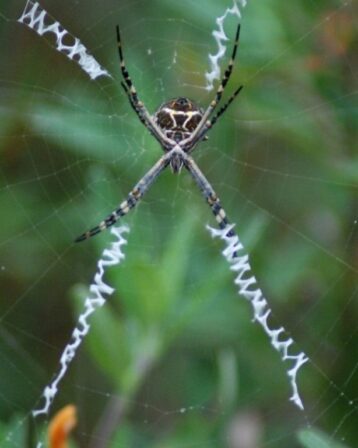Hidden in Plain Sight
(Part 1)
By Barb Strona
Most people spend much of their leisure escaping into other’s worlds via TV, Internet, newspapers, or books. Meredith French, master gardener and long-time Mission Hills Garden Club supporter in every possible way, showed The Mission Hills Garden Club another source of love and lust, family relationships, and murder and intrigue. It is right before your eyes, but most people are as unaware of it as they would be of world events were it not for the media. Best of all, escaping into this other world costs nothing and leaves no carbon footprint. It is as accessible as the outdoors.
If lusty novels are your cup of tea, the life of a ladybug beetle (or lady bird beetle in Europe) may satisfy you. There are 125 species just here in California alone. In general there are over one million identified insect species and perhaps 20 million that are still to be identified. There are 26 orders, some with wings, some without. Beetles comprise the largest order with 350,000 species of beetle. Most beetles have a slit resembling a black line down the center of their backs. They have two sets of wings–the soft flexible wings on top, and hard protective wings underneath. They can live anywhere: in trees and shrubs, water, under bark, in soil.
“Armed and dangerous,” according to Meredith French, ladybugs are toxic to many vertebrates have few enemies. Their red coloring also warns enemies of toxicity. Known for a fondness for aphids and other soft bodied “pests,” ladybug larvae eat many more aphids than do the parents. These larvae look like small alligators. Ladybugs lay their eggs right in the middle of a colony of aphids. When the larvae appear, dinner is ready to eat. The adults, according to French, are more interested in mating than in eating aphids. All that sex leads to their laying as many as 500 eggs in a few months, eggs that hold ravenous aphid-devouring larvae. Despite their mass murdering habits, in Medieval times people thought the Virgin Mary sent them to “help in the war against destructive pests, especially those of their precious grape vines and were called Our Lady’s Beetle,” she told us.
During the winter months ladybugs migrate and hibernate in mass before returning to their summer homes. While they rest, they are often trapped and taken to nurseries where they are sold in boxes. This is unnecessary because they return of their own free will, arriving about the same time as the aphid populations begin to grow.
Until they have reproduced, much the aphid population is safe from them.
However, another creature, also a mass murderer and sex addict, is the Syrphid or hover fly. Like the ladybug beetle, the adult hover fly is definitely lusty. They often hover around your face, perhaps trying to discern if you are something with which to mate. Resembling a very small wasp, birds shun them, thinking they can sting. Since they are flies, they cannot sting. The larva form of Syrphid “is an aphid eating monster,” says French. They eat dozens a day, “up to one a minute.” The adults live on nectar and are good pollinators.
Some killers are truly “lurking predators.” The Robust Assasin Bug is one who hangs out in yarrow. She seizes her prey in her sticky front legs. With her “long curved stiletto proboscis” she injects her victim with venom that liquefies it. Within an hour, it has been ingested.
Blue Mud Wasps favor black widows for her children’s dinner. She anesthetizes her catch, brings it home, and lays an egg or two on its body. This way the spider lives and the wasp’s larvae can feed on the live spider. Adult male wasps need nectar to survive. This family pollinates, tortures, nurtures and kills.
The Threadwaisted Wasp has some habits similar to the Blue Mud Wasp’s. Both live underground and lay eggs on their prey to keep them alive. The Threadwaisted Wasp, however, feeds her young on live caterpillars and traps them underground with a rock covering the entrance. She removes and replaces it for her own ingress and egress.
The Silver Argiope is the clever Vampira of spiders. When she weaves her web, its multiple diagonals or spokes are not sticky. These diagonals allow her to weave the circular sticky filaments between the spokes without getting caught herself. In addition, she creates four stabilmenta or ladders, on four of the spokes.
The theory behind this construction, French explains, is four fold: it makes the web more visible to larger uninterested creatures; it makes her appear larger since the ladders are extensions of her four sets of two legs; The ladders strengthen the web to make it less necessary to rebuild it each night; the ladders allow a male to enter her inner sanctum without entrapment. Usually she then kills him as food for her soon to be spiderlings. Her post-coital activity is to kill him as food for her soon-to-be spiderlings. May papa Rest in Peace.
Naturally, as soon as they finish mating, she finishes him—i.e. she eats him. Again, Rest in Peace.
There are no Mission Hills Garden Club meetings during the month of July and August, but next month’s column will focus more on family relationships and the way these creatures produce and care for their young. Then I will touch on the importance of all this drama. French is available to share this very interesting talk on insects in your garden with clubs and organizations.
Category: Local News








